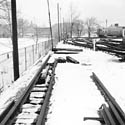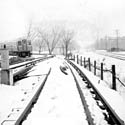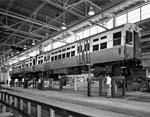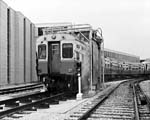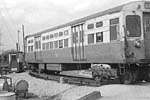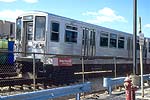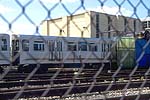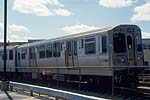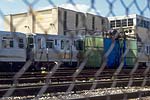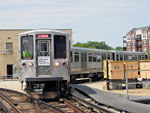
To celebrate the
opening of the new Desplaines Shops, an open house
was held on July 27, 1962 to show off the
facilities to CTA employees, their families, and
guests. In addition to the maintenance bay,
visitors got to see CTA's latest cars, the
6000-series (note in the middle foreground is one
of the high-speed experimental cars), and see them
up on the hoists. For a larger view, click
here.
(Photo from the CTA
Collection)
|
By Fall 1961, the steel structure for the service and
inspection shops, was erected and masonry work on the tan
brick exterior had begun. The shop was completed and entered
service in July 1962. The shop building, constructed at a
cost of $969,900, covered an area of 26,000 square feet and
was large enough to accommodate 12 cars at a time total on
three tracks. In addition to the new shop, all six existing
yard tracks were extended eastward and a seventh yard track
was added, which provided access to the shop leads. Tracks
for outside storage of 100 rapid transit cars during
off-peak periods were provided for in the overall
installation, and parking space for almost 500 automobiles
is available at or near this terminal. The total project was
completed at a cost of $1,180,000.
On Monday, July 1, 1968, two more yard tracks, 1-W and
2-W, were placed in service to compensate for loss of
capacity at Logan Square
Yard during the construction of the Kennedy
Extension. These tracks, which extend west along the
south property line behind the shop, were actually a
reactivation of the the old CA&E tracks that were laid
in 1959, but never used, to connect the CA&E
right-of-way with Desplaines
Terminal.
For many years, Desplaines Shops handled nearly all of
the car inspection and maintenance for both branches at the
south end of the West-Northwest Route -- both the Congress
and Douglas branches --
since the 54th Yard at the end of
the Douglas had no shop building and only an outdoor
inspection pit. After building a small shop at 54th
in the 1970s, most car maintenance for the Douglas
branch moved there, although Desplaines remains the
larger and more comprehensive of the two shops.
Over the years some additional small improvements have
been made to the yard. As part of the reconstruction of
Desplaines
station, a new yard selection panel was put in service on
April 7, 1980 to control access to the yard from the station
track. On October 2, 2000, new procedures were put in effect
for trains moving to and from Forest Park Yard (as the yard
become known, following a change in nomenclature for the
Congress branch to the "Forest Park branch"): trains moving
from the north station track to the yard [lay-ups]
now use the Outer Lead Track, while trains moving from the
yard to the south station track [put-outs] use the
Inner Lead Track.
Desplaines shops and yards serves the Forest Park
[Congress] branch of the
CTA Blue Line. Today,
the yard can accommodate 122 cars, excluding the loop, shop,
and lead tracks. The 1960s shop building is still in use.
The large CTA logo on
the west elevation of the building is gone, but the large
letters spelling "CHICAGO TRANSIT
AUTHORITY" standing on the south elevation's canopy
are still extant (although some letters are
replacements).
|




